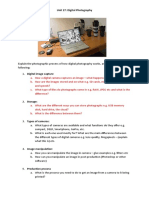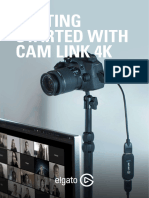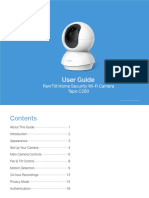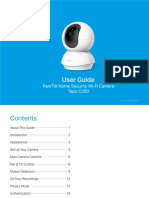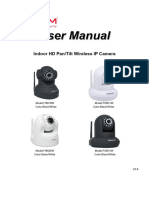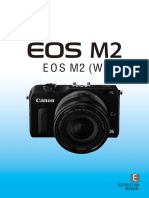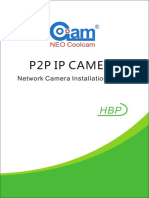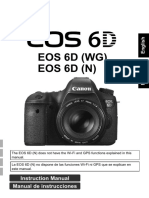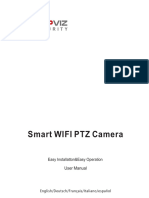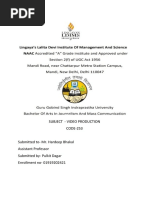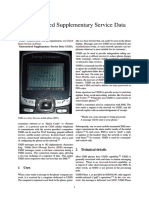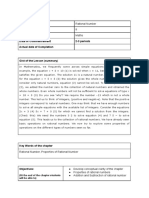Computer 10 The Camera
Computer 10 The Camera
Uploaded by
acrtannCopyright:
Available Formats
Computer 10 The Camera
Computer 10 The Camera
Uploaded by
acrtannOriginal Description:
Original Title
Copyright
Available Formats
Share this document
Did you find this document useful?
Is this content inappropriate?
Copyright:
Available Formats
Computer 10 The Camera
Computer 10 The Camera
Uploaded by
acrtannCopyright:
Available Formats
LIDE Learning Center, Inc.
Isabel, Leyte
Notes in Computer 10
SY: 2023 – 2024
NAME:
SECTION:
THE CAMERA 3. Headphone Jack
The most basic digital tools for making your video are a By connecting a pair of headphones to your
digital still camera and a digital video camera camera, you will be able to monitor the sound of
your video. So, if any unwanted noise comes up,
A “digital still camera” (also called digicam) takes
you can immediately make adjustments to avoid
still pictures which are stirred in a media card. After
it.
taking pictures, the media card can be removed and
then inserted into a computer so you can upload
the pictures you have taken. The number of pictures 4. Microphone Jack
you can make is based on the memory capacity of
your media card. First of all, built-in microphones are notoriously
poor performers. It is good to just record normal
video. But if professional audio is required, it
A “digital video camera” takes moving pictures and
stores them in either a digital video cassette or a cannot be relied on. As a result, external mic is
digital video disc. designed to solve the problem.
The microphone that comes with your camera is
Newer digital still camera and digital video camera
already of good quality. But, for some specialized
have features on capture both still shot images and
movies. The difference between the two lies in the uses such as when you want to get a clear
number of options available for still shot images and interview of a person in a noisy room, you may
need to use an external microphone. You attach
movies.
it to your camera through the microphone jack.
BASIC DIGITAL VIDEO CAMERA PARTS AND
5. FireWire In/Out
FEATURES
FireWire, also called IEEE 1394 or i. LINK, high-
1. Manual Controls speed computer data-transfer interface that was
Look for cameras that let you control the settings used to connect personal computers, audio and
manually. Auto functions are convenient and will serve video devices, and other professional and
well on most occasions but there are certain situations consumer electronics.
where being able to manually control the focus, white
balance, and exposure is essential. FireWire allows you to transfer audio and video
data between your camera and computer. This
a. Focus - Focus simply moves the camera lens, comes with all MiniDV and Digital8 cameras.
adjusting the “focus point”.
b. Exposure - Exposure time (sometimes called BASIC DIGITAL VIDEO CAMERA PARTS AND
“shutter speed”) is the length of time the FUNCTIONS
camera is exposed for. 1. Viewfinder
c. ISO - refers to how “sensitive” the camera is.
d. White Balance Allows you to see what your camera is
recording.
2. Audio-Video In/Out Jack Information such as:
- Battery life
You can connect your camera to a TV or monitor through - Time code
a cable attached to your AV in/out jack. This is useful if - Time left on tape and etc.
you want the images you recorded (or are recording) to
be viewed on TV.
2. LCD 6. On-board Microphone
Some cameras the LCD swivels out from the Digital video cameras often have built-in
side. microphones, which work fine for regular use.
Displays the same information that you can see However, most filmmakers use external or
in viewfinder, only larger attached microphones for enhanced sound.
Allows you to make minor adjustments on focus
and exposure
7. Record Button
3. Lens
An important part of the shooting is to press the
record button and begin recording. Pressing the
Collects light and focuses the image onto your
record button again also stops the recording.
camera's sensor chip.
Usually indicated with a red dot and is usually
Lenses may come with manual focusing ring
located where your thumb sits when holding the
that lets you adjust the focus.
camera with your right hand
4. Zoom Rocker
8. Battery
This lets you quickly adjust your lens angle from
Each camera brand and model has its own
a wide-angle to a telephoto lens, depending on
battery pack.
the kind of shot you need to make.
5. Tape Bay Most cameras require standard AA batteries.
The tape bay is where you put the tape/ memory Digital cameras require a robust power source
card. for functionality, so most DSLRs and mirrorless
cameras take advantage of the benefits provided
by lithium-ion batteries (Li-ion)
Some cameras use an SD card or micro SD card.
Other cameras do not have any tape bays or slots
9. Tripod Mounting Nut
but have an internal hard disk drive where the
movie will be saved
This is found at the bottom of the camera.
You secure the screw of your tripod's mounting
plate onto this to mount your camera on the
tripod.
Reference: Tech Factors INC: Video Production and
Digital Photography for beginners (4th Edition)
You might also like
- User Guide: Wireless Pan/Tilt Home Security HD22M102MNo ratings yetUser Guide: Wireless Pan/Tilt Home Security HD22M102M34 pages
- Lecture 5 Geographical, Climatic, Religious, Social, Historical Aspects of Architecture.100% (1)Lecture 5 Geographical, Climatic, Religious, Social, Historical Aspects of Architecture.12 pages
- OI - 001 - Supplier Feasibility Commitment: Feasibility Level of The Product Feasible Not FeasibleNo ratings yetOI - 001 - Supplier Feasibility Commitment: Feasibility Level of The Product Feasible Not Feasible1 page
- Lesson 4 The Camera and Other Digital ToolsNo ratings yetLesson 4 The Camera and Other Digital Tools4 pages
- Complete Course Notes of 205 Lighting in VideoNo ratings yetComplete Course Notes of 205 Lighting in Video145 pages
- Unit 6 - Digital Photography and VideographyNo ratings yetUnit 6 - Digital Photography and Videography7 pages
- PoE_-Techage_-_80mm-113.16mm_XMeye_20220917No ratings yetPoE_-Techage_-_80mm-113.16mm_XMeye_2022091727 pages
- User Guide: Pan/Tilt Home Security Wi-Fi Camera Tapo C200No ratings yetUser Guide: Pan/Tilt Home Security Wi-Fi Camera Tapo C20025 pages
- U21 Mini WiFi USB IP Camera. Instruction. EnglishNo ratings yetU21 Mini WiFi USB IP Camera. Instruction. English10 pages
- User Guide: Pan/Tilt Home Security Wi-Fi Camera Tapo C200No ratings yetUser Guide: Pan/Tilt Home Security Wi-Fi Camera Tapo C20024 pages
- INTRODUCTION To Desktop Editing and PhotographyNo ratings yetINTRODUCTION To Desktop Editing and Photography41 pages
- Black Doodle Group Project Presentation - 20231101 - 215806 - 0000No ratings yetBlack Doodle Group Project Presentation - 20231101 - 215806 - 00007 pages
- User Manual for FI9818W FI9821W FI9826W FI9831W_V2.8_EnglishNo ratings yetUser Manual for FI9818W FI9821W FI9826W FI9831W_V2.8_English81 pages
- Httpsgdlp01.c Wss - Comgds9030001784901eosm2 Im en PDFNo ratings yetHttpsgdlp01.c Wss - Comgds9030001784901eosm2 Im en PDF364 pages
- P2P Ip Camera: Quick Installation ManualNo ratings yetP2P Ip Camera: Quick Installation Manual20 pages
- CamHi App User Manual Android Version ENNo ratings yetCamHi App User Manual Android Version EN12 pages
- Manual de Cámara Domo PTZ (Inglés - Francés - Alemán - Italiano - Español) para (WP-245W - WP-25505W - WP-244W)No ratings yetManual de Cámara Domo PTZ (Inglés - Francés - Alemán - Italiano - Español) para (WP-245W - WP-25505W - WP-244W)119 pages
- User Manual: Downloaded From Manuals Search EngineNo ratings yetUser Manual: Downloaded From Manuals Search Engine11 pages
- "Digital Still Cameras" "Digital Video Cameras"No ratings yet"Digital Still Cameras" "Digital Video Cameras"3 pages
- Camera User Guide: Basic Operations Advanced OperationsNo ratings yetCamera User Guide: Basic Operations Advanced Operations218 pages
- PoE Add On Camera Quick Start Guide March 2022No ratings yetPoE Add On Camera Quick Start Guide March 202229 pages
- El Filibusterismo Summary Each Chapter English100% (2)El Filibusterismo Summary Each Chapter English6 pages
- Analogies, Plot Elements, Themes in Literature PowerpointNo ratings yetAnalogies, Plot Elements, Themes in Literature Powerpoint56 pages
- Artificial Contraceptives Issue (Edukasyong Pangkatao)No ratings yetArtificial Contraceptives Issue (Edukasyong Pangkatao)3 pages
- SCIENCE REVIEWER (1st Quarter Topics) For Grade 10 - PhysicsNo ratings yetSCIENCE REVIEWER (1st Quarter Topics) For Grade 10 - Physics2 pages
- 21st Century Literature 2nd Quarter Week 1 DLLNo ratings yet21st Century Literature 2nd Quarter Week 1 DLL4 pages
- Ajat Philippines, Inc.: Customers Information SheetNo ratings yetAjat Philippines, Inc.: Customers Information Sheet2 pages
- Mobiltherm 43: Premium Heat Transfer OilNo ratings yetMobiltherm 43: Premium Heat Transfer Oil1 page
- Real Time Integrated Reservoir Operation-CSocrNo ratings yetReal Time Integrated Reservoir Operation-CSocr71 pages
- Criteria Poor Satisfactory Good Excellent: Report Content (15 Marks)No ratings yetCriteria Poor Satisfactory Good Excellent: Report Content (15 Marks)4 pages
- Air Conditioning Compressor Types - AC Compressors100% (2)Air Conditioning Compressor Types - AC Compressors3 pages
- The A-Theory, The B-Theory, and Temporal Counterpart TheoryNo ratings yetThe A-Theory, The B-Theory, and Temporal Counterpart Theory4 pages
- Yu Et Al. - 2020 - Gradient Surgery For Multi-Task LearningNo ratings yetYu Et Al. - 2020 - Gradient Surgery For Multi-Task Learning27 pages
- Resm 7901 Postgraduate Research MethodologyNo ratings yetResm 7901 Postgraduate Research Methodology2 pages
- Bc. Zuzana Medvedíková 2 Basm English and Slovak Color Idioms100% (2)Bc. Zuzana Medvedíková 2 Basm English and Slovak Color Idioms5 pages
- Karanijukar Hydroelectric Projectr - Iceland: The DamsNo ratings yetKaranijukar Hydroelectric Projectr - Iceland: The Dams4 pages
- What Is Engineers Australia Competency Assessment Stage 2 For Chartered Professional Engineer (Cpeng)No ratings yetWhat Is Engineers Australia Competency Assessment Stage 2 For Chartered Professional Engineer (Cpeng)9 pages
- 1.what Are The Challenges Faced by Adolescents?No ratings yet1.what Are The Challenges Faced by Adolescents?3 pages




